|
LEM278 DXpedition to Lemmenjoki
October 3-10, 2009
by Mika
Mäkeläinen
The beginning of October was the
earliest I have ever been to Lapland for a DXpedition,
so I anticipated rather short peaks of intensive
listening only at sunrise and sunset. Capturing
these brief moments of good propagation was however
easier than ever before, because both I and accompanying
DXer Pertti Äyräs were equipped with software-defined
receivers. LEM278 was the first DXpedition where
I didn’t even bother to take along a single
traditional communications receiver, and I have
no regrets. Working with two Perseus receivers and
two laptop computers was much less hassle.

Reindeer, King of the Road in Lapland |
We met — for the first time in years —
at my new home in Vantaa after midday Friday, October
2. Pertti had begun his travel already a couple
of hours earlier from his hometown near Turku. Pertti
left his car at my place, and we loaded both our
stuff to my Nissan Murano, which became full even
though one would expect DXpedition luggage to begin
shrinking along with the size of the receivers.
Maybe it is us who keep on growing.
We set out at 1 pm, and drove north until 8:30
p.m. when we arrived at the summer cottage of fellow
DXer Jari Ruohomäki in Muhos. His cabin is
a well-known and well-equipped AM listening base,
but we spent the evening enjoying Jari's gourmet
Indian cooking as well as admiring his collection
of Latin American verifications — with plenty
of drinks to compensate for any possible dehydration
on the way.
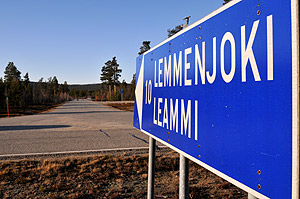
Destination ahead - about 1150 kilometers from
the start. The second line shows the Sami language
spelling. |
We woke up on Saturday at 6 a.m. when Jari was
already listening to Venezuelan AM stations. We
left just before daybreak around 7 a.m., and eventually
arrived in Lemmenjoki at about 3:45 p.m. in the
afternoon, after about 1150 kilometers of driving.
Although road conditions this early in the season
were very good, on the way we had to keep a constant
watch for cops and other wildlife, both of which
can cause expensive surprises. A couple of days
later I heard in the news that someone had blown
up an automated speed surveillance camera near Rovaniemi
on the Arctic Circle. No, it wasn't me, and I have
logs to prove it... Even
though the camera poles are placed profitably right
after signs indicating a lower speed limit, using
explosives sounds like a pretty extreme reaction.
Further north it makes sense to drive cautiously
even when there is no risk of a speeding ticket.
We saw reindeer on the road several times, and once,
close to the village of Pokka, a giant bull moose
crossed the road in front of us. An awesome sight.
The moose hunting season was underway, but we had
better catches in mind.

Looks and feels almost like summer |
In Lapland, having no snow on the ground and temperatures
hovering comfortably around freezing point qualify
as summer. And indeed everything was very different
from the winter. There was no ice on the lake, the
landscape was mostly green, and most importantly,
the sun was still up. All this makes for a pleasant
difference compared to mid-winter, when any outdoor
activity easily turns into a survival lesson. However,
on Wednesday, October 7 we got quite a blizzard,
dropping 15-20 centimeters of snow in 24 hours,
a forceful beginning of the winter.
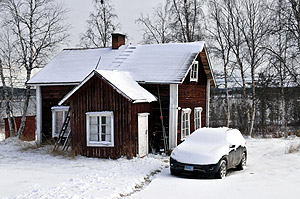
What a difference a day makes |
For us, LEM278 marked the end of a transition phase
in receiver technology. For the first time we used
exclusively software-defined receivers, so there
was more room on the table, and the listening experience
was more relaxed. The biggest worry was to ensure
that the laptops and the Perseus software were working
normally, and then you could just sit back and enjoy
the sounds. Or, as we are passionate to make new
discoveries on the dial, use the extra time to keep
on checking for some more exotic targets, and to
keep track of any subtle changes in the direction
of propagation conditions.

Ice forming on Lake Menesjärvi near Lemmenjoki |
Preceding DXpeditionists Jim
Solatie and Håkan Sundman had captured
a record haul of Australian AM stations, so we also
had high hopes for an unprecedented opening to Oceania.
On arrival, Asian stations were bound to emerge
from the static any minute, so in a hurry we began
to assemble our computer-based equipment, which
to an outsider basically look like a bunch of boxes
with an unbelievable amount of wires running around.
In slightly over an hour the first rigs were operable
and we were able to immediately check out the sunset
session of Asian stations. Solar weather at least
seemed favorable, but sometimes not even a quiet
sun guarantees favorable conditions. Overall, reception
conditions during our DXpedition week were good,
but not exceptional. Trans-Atlantic signals landed
in our small cabin at best for nearly 12 hours a
day, but propagation could have been more varied
and localized. Now we mostly got the regular powerhouses
day after day, and propagation patterns were very
similar nearly every day. Here is a more detailed
look at the propagation indices during the DXpedition:
| Date |
Solar
flux at Earth |
Sunspot
number |
Planetary
A index |
K
indices (3-hour intervals) |
Min-max
solar wind speed (km/sec) |
Number
of flares (events) |
| STAR |
NO
AA |
STAR |
NO
AA |
Daily low- high |
Planetary |
Boulder |
C |
M |
X |
| 1.10.2009 |
72.0 |
0 |
11 |
2.5 |
2 |
0-5 |
11010010 |
11111100 |
287-346 |
|
|
|
| 2.10.2009 |
71.6 |
0 |
0 |
2.3 |
2 |
0-4 |
11001101 |
01011000 |
284-347 |
|
|
|
| 3.10.2009 |
71.6 |
0 |
0 |
1.3 |
1 |
0-3 |
00001001 |
00001100 |
275-323 |
|
|
|
| 4.10.2009 |
71.1 |
0 |
0 |
4.1 |
4 |
2-7 |
12111011 |
02122101 |
280-410 |
|
|
|
| 5.10.2009 |
69.9 |
0 |
0 |
1.9 |
2 |
0-3 |
01000101 |
01000110 |
317-401 |
|
|
|
| 6.10.2009 |
68.9 |
0 |
0 |
1.3 |
1 |
0-4 |
01000000 |
01000000 |
285-348 |
|
|
|
| 7.10.2009 |
68.5 |
0 |
0 |
1.5 |
2 |
0-4 |
00001000 |
00010000 |
279-312 |
|
|
|
| 8.10.2009 |
68.8 |
0 |
0 |
2.3 |
2 |
0-4 |
11000011 |
01001101 |
273-316 |
|
|
|
| 9.10.2009 |
69.2 |
0 |
0 |
3.4 |
3 |
0-5 |
01111111 |
01112110 |
287-325 |
|
|
|
| 10.10.2009 |
70.0 |
13 |
0 |
2.3 |
2 |
0-5 |
00011011 |
00011100 |
271-307 |
|
|
|
| 11.10.2009 |
70.4 |
0 |
0 |
6.1 |
6 |
4-12 |
11311221 |
22322310 |
274-417 |
|
|
|
(information
collected by Jan Alvestad)
And here's a detailed description of actual day-to-day
propagation conditions as we experienced them. For
comparison, DXers in Tampere have published a report
of their catches on October 7-8 (report
in Finnish). Closer to us, fellow DXer Tuomo
Ahonen was DXing U.S. stations in Enontekiö
in Lapland from October 4th onwards, and his remarks
can be read in the PUDXK blog
(in English). In Sweden, Gert Nilsson has published
his loggings of October
6 and other days.
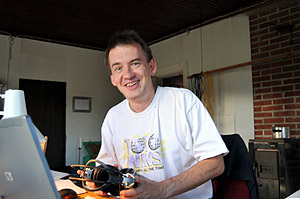
I also heard 1010 WINS on the radio, a rather
easy catch in Lemmenjoki |
Saturday, October 3, 2009:
We arrived in Lemmenjoki early enough to get first
recordings running by 1400 UTC, when the strongest
Far East stations were starting to push through
the noise. Conditions improved a bit by 1500 UTC,
but were still very wide, so everything from Japan
to India was found on the dial. The 1600 UTC top-of-the
hour was best, and conditions favored China, Indo-China
and India. Bangladesh on 693 kHz had a booming signal.
No sign of any Aussies despite frantic scanning
of the X-band for any signs of life.
Sunday, October 4, 2009:
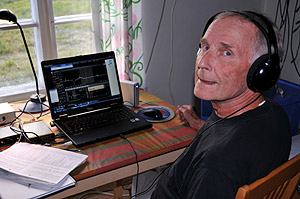
Pertti Äyräs almost ran out of storage
space for recordings |
The first Newfoundland stations (590, 930, 1210
and 1400 kHz) appeared around 2100 UTC on Saturday
evening. A couple of the most common daytime stations
were logged tentatively, and reception of trans-Atlantic
signals improved gradually. Conditions seemed to
favor the East Coast of North America, Ontario,
and later in the morning around 0400 UTC, also the
Rockies. During all that time, stations from Colombia,
Venezuela and Puerto Rico were relatively strong.
Latin American signals peaked around 0500 UTC, and
especially the lower end of the AM dial offered
nice surprises. Our instant catches include Radio
Auténtica, Bogotá (540 kHz), ZIZ Radio
from St. Kitts (555 kHz), WUNO San Juan PR (630
kHz) and Caracol, Bogotá (810 kHz), but there
are bound to be many more. Signals lost power rapidly,
but 0600 UTC was still quite good. I turned my receivers
off after 0700 UTC, when only a bunch of regular
catches, mostly from Canada, remained audible. In
the afternoon, a few Alaskan and U.S. West Coast
stations appeared when the sun was still high up,
but nothing worth listening to. Chinese stations
became audible around 1230 UTC, earlier than the
previous day. Signals from Asia were overall very
strong, but conditions were spread over such a large
area that finding new stations is going to be a
challenge. Again no coveted Aussies, except for
a few weak X-band stations.
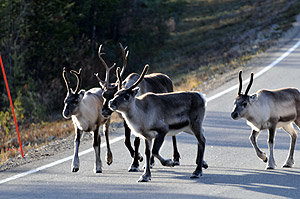
How about sharing the road? |
Monday, October 5, 2009:
This night offered pretty good conditions to North
America. The first Newfoundland stations were heard
around 2200 UTC Sunday, and with nightfall creeping
westwards, new stations became audible all the way
to the West Coast, where darkness fell around 0200
UTC. Conditions were limited to the upper half of
the AM band, but signals were strong and European
interference weaker than usual. Graveyard channels
began yielding recognizable signals after 0200 UTC.
Among the best catches were KTNO University Park
TX on 1440 kHz, which probably forgot daytime power
on, judging by its monster signal, and KGOW Bellaire
TX on 1560 kHz, heard for hours. Overall however
Canadian stations were on top of the pile, and such
northerly U.S. stations as the new KYES Rockville
MN 1180 kHz and KFNW West Fargo ND 1200 kHz were
audible for hours. This was the best propagation
from North Dakota that I have ever experienced,
including such catches as 1370 KWTL and 1450 KZZJ.
In the morning, while North American stations remained
dominant, there was a very nice opening towards
the southern half of South America at about 0415-0500
UTC, with a few other Latin Americans in the mix,
and focused luckily on the lower end of the dial.
I have never before heard so many Latin American
stations on the bottom AM frequencies (including
Radio Colonia, Uruguay on 550 kHz). Soon after 0500
UTC signals from all over the Western Hemisphere
began to lose steam. The northwestern corner of
the U.S. and a handful of dominant stations from
elsewhere lingered around past 0600 UTC and didn't
fizzle out for hours. It was quite impressive to
hear some stations from the Rockies and the West
Coast sticking around long into the afternoon, even
though signals were weak. A few common Hawaii stations
were heard for hours, but nothing new. Later in
the afternoon, Japanese stations popped up around
1300 UTC, but conditions soon degenerated into a
typical pan-Asian mess with stations from all around
— except from Oceania.
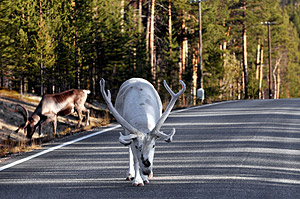
I'm not afraid of one lousy car |
Tuesday, October 6, 2009:
Newfoundland stations opened the night as usual
on Monday evening, followed soon (2230 UTC) by WEGP
1390, and the most common Puerto Rican stations
at 2245 UTC. Most North American stations soon disappeared,
while a mixture of Latin Americans kept us guessing
what to hunt next. North Americans returned gradually
around 0100 UTC, and improved until the signals
quickly deteriorated around 0530 UTC. The most common
West Coast stations remained weak on the dial for
hours afterwards. In the early morning hours signal
strength was decent, but conditions favored the
same area as before, Minnesota and North Dakota,
as well as the Canadian Prairie. There was a short
morning opening to Latin America around 0400 UTC.
Our best catches include KATL Miles City MT and
KKOB Albuquerque NM both on 770 kHz, as well as
KOOQ North Platte NE on 1410 kHz. In the afternoon,
the first Japanese stations opened the Asia session
at 1300 UTC, but once again conditions covered such
a wide area that finding anything new was challenging.
Vietnam easily beat Norway on 630 kHz, which —
fortunately — has sounded relatively weak this
week. Australian X-band stations were noted at 1500-1600
UTC, but nothing out of the ordinary, or at least
not before we get to review our recordings.

Snow-covered Tuorpumapää seen behind
Lake Mutusjärvi in Inari. |
Wednesday, October 7, 2009:
Trans-Atlantic signals emerged gradually after
2300 UTC, with North America dominating after midnight
UTC. The signals were fairly strong until around
midday, including even stations from the Eastern
half of North America. Canadians tended to dominate
frequencies, but also some Mexicans were heard.
As stations from all over the continent were represented,
it was difficult to get any decent signals on the
graveyard frequencies, and even elsewhere, frequencies
tended to be dominated by the usual suspects. Around
sunrise there was a typical opening to the Caribbean,
Colombia and Venezuela. It was a pleasant surprise
to hear some Alaskan and Hawaiian stations in the
afternoon, especially the Hawaiian music played
by KKNE Waipahu on 940 kHz, audible past 1600 UTC,
although this is of course not a rare station. In
the afternoon, I began recording Asian stations
at 1220 UTC, and gradually signals grew stronger
than on any previous day. However, again everything
from Japan to the Persian Gulf seemed to flood the
AM band at once. The most common Philippine stations
(on 954, 1062, 1233 and 1314 kHz) were noted in
the mix. Bjarne Mjelde was simultaneously listening
in Norway, and alerted us to New Zealand on 1035
kHz, but not a trace of the station was observed
here. How unfair — seems like the border control
extends even to the airwaves... Just before surrendering
the AM band to Europeans, a few Koreans were identified
at 1600 UTC, among them KCBS Wiwon on 719.87 kHz
and HLKG Daegu on 738 kHz.
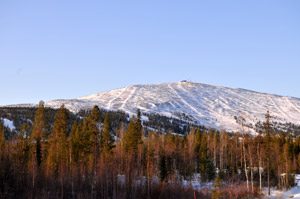
On return we briefly stopped at Ylläs ski
center to admire the view. |
Thursday, October 8, 2009:
The night session began on Wednesday evening at
2200 UTC with quite good signals from Brazil, but
unfortunately the national "A Voz do Brasil"
is aired precisely at that time, so getting station
identifications was impossible. After the end of
the program, conditions had shifted further southwest,
favoring Argentina and Uruguay. Our catches include
Rádio Tupinambá, Brazil, on 1120 kHz,
and Radio Azul, Argentina, on 1320 kHz. North American
stations emerged around 0220 UTC, after which conditions
focused on Atlantic Canada, Canadian Prairie and
the Pacific Northwest. Cubans were heard after 0500
UTC for a couple of hours, but then conditions to
all directions dwindled. Recordings will hopefully
reveal something more, especially from South America
earlier in the night, but conditions towards North
America were still disappointing. In the afternoon,
Japanese stations marched in force around 1200 UTC.
During the ensuing four-hour Asian session especially
Chinese signals were very strong, but once again
conditions tended to favor such a large area that
finding anything beyond the common dominants is
cumbersome.

Any intention of moving? |
Friday, October 9, 2009:
Brazilians were the first to cross the Atlantic
around 2200 UTC on Thursday evening, but weaker
than the previous day. Nighttime conditions were
similarly mixed, with Atlantic Canada being consistently
strong, and weak outbursts from the La Plata area,
Puerto Rico and East Coast North America (catches
including Radio Antares from Argentina on 1650 kHz
and WKOX Newton MA on 1200 kHz). In the wee hours
North American propagation improved, and by dawn
there were stations on just about every frequency.
Signal strength was very good, but it would have
helped to have a more narrow focus area. In the
afternoon, Asian signals were stronger than on previous
days, but followed a typical all-at-once pattern.
Just a few Aussies were caught, even though much
more was heard at the same time in Parkalompolo
in Sweden.
Saturday, October 10, 2009:
On our last night conditions to Latin America were
very good. Venezuela and Colombia had the best signals.
North American stations improved later at night,
with conditions shifting to the Northwestern corner
by early morning. Many Cubans remained in the mix
for hours after sunrise, with such catches as Radio
Libertad on 1350 kHz, at 0800 UTC, which is remarkably
late considering it was still early October. We
pulled the plug around midday, and left behind the
best conditions of the week. It looked like the
next dxpeditionists, Martti
Karimies and Jari Sinisalo, due to arrive on
Saturday evening, would have quite a feast.
A relaxing week came to an end, and it was time
to say goodbye to Lemmenjoki — although both
of us plan to return later this season. Our return
trip went smoothly, first driving from Lemmenjoki
to Kolari on the Swedish border, and then by train
overnight from Kolari down to Helsinki. The train
was more than half-empty, as this was not a tourist
season, and so it was also very quiet. I slept like
a baby.
Published
on October 14, 2009
  
|